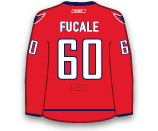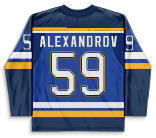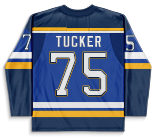Murray is 1-1-0 with a 3.52 GAA and .825 SV% with the Dallas Stars and has been loaned to the Texas Stars (AHL) on Tuesday. The 25-year-old netminder returns to Texas, where he was 14-9-5 with a .909 SV% and 2.36 GAA.

Murray is 1-1-0 with a 3.52 GAA and .825 SV% with the Dallas Stars and has been loaned to the Texas Stars (AHL) on Tuesday. The 25-year-old netminder returns to Texas, where he was 14-9-5 with a .909 SV% and 2.36 GAA.

Poirier was 5-3-2 with a .913 SV% and a 2.48 GAA with the Texas Stars (AHL) and has been recalled to Dallas for the first time in his career. The 21-year-old is on an impressive rise this season, as he has played the majority of his games in the ECHL in 2022-23 and was a 2020 sixth-round pick (185 overall).

Patera was excellent in his short two-game showing with the Vegas Golden Knights, going 2-0-0 with a .929 SV% and 2.50 GAA but has been reassigned to Henderson (AHL) Monday. The 24-year-old returns to the Silver Knights, where he was 12-13-1, with a .916 SV% and a 2.66 GAA.

Daccord has a 24-6-3 record, .915 SV% and 2.43 GAA with the Coachella Valley Firebirds (AHL) and has been recalled on an emergency basis Monday due to Philipp Grubauer being day-to-day with an illness. Daccord is expected to backup Martin Jones for the time being.

Fedun has three goals, seven assists, 20 PIMs and a -2 plus/minus through 53 games played with Wilkes-Barre/Scranton (AHL) and has been recalled to Pittsburgh for the first time this season. The 34-year-old will replace the injured Marcus Petterson in Pittsburgh's lineup and will hope to add to his 35 career points (8G/27A) through 127 career GP.

Bolduc has 10 goals, 25 assists, 31 PIMs and a -13 plus/minus through 56 games played with Bridgeport (AHL) and has been recalled to the Islanders for a second time this season. The 22-year-old returns for a second stint to the Islanders, where he had a goal, six assists, and two PIMs through six games earlier in the year.

Koivula had two assists, five SOG, four PIMs and a +1 plus/minus through eight games this season and has been returned to Bridgeport (AHL) on loan Monday. The 24-year-old returns to Bridgeport, where he had 12 goals and 13 assists through 45 games played earlier in the season.

Zamula had a goal, 15 assists, 12 PIMs and a -5 plus/minus through 42 games this season with Lehigh Valley (AHL) and has been recalled to the Flyers yet again Monday. The 22-year-old returns to the Flyers lineup, where he had two assists, six SOG and a -1 plus/minus through 11 games earlier in the season.

Agozzino leads the Barracuda with 52 points (24G / 28A) in 55 AHL games this season. He replaces William Eklund on the Sharks' roster and could make his San Jose debut on Monday. Agozzino has been a terrific AHL producer throughout his career but has just nine points (2G / 7A) in 47 NHL games with the Avalanche, Ducks, Penguins and Senators.

Eklund picked up two goals and one assist (three points) in eight games with the Sharks during his call-up. The 20-year-old winger returns to the AHL, where he is second on the team with 41 points (17G / 24A) in 52 games. Andrew Agozzino was recalled in a corresponding move to take Eklund's spot on the roster.

Guzda served as Sergei Bobrovsky's backup for the last couple of games but returns to the AHL with Alex Lyon coming back up. Guzda has gone 14-7-3 with a 2.85 GAA and .900 SV% in 25 AHL games this season.

As expected, Lyon returns from the AHL and is expected to start either Monday in Detroit or Tuesday in Philadelphia. Lyon has gone 13-9-1 with a 2.43 GAA and .910 SV% in 23 AHL games this season.

Ferguson signed with the Senators on March 2nd and has gone 5-1-0 with a 2.00 GAA and .935 SV% in six games with Belleville. The Senators have a back-to-back on Monday/Tuesday, so there's a chance that Ferguson will make his second career NHL appearance and Senators debut.

Mandolese has been serving as Mads Sogaard's backup, so he'll return to Belleville for some playing time. The 22-year-old netminder has gone 6-7-2 with a 3.32 GAA and .889 SV% in 15 AHL games this season.





Afanasyev failed to pick up a point in three games with the Nashville Predators in his last showing with Nashville but returns Saturday after spending only a day down in Milwaukee (AHL). The 22-year-old returns from the AHL, where he had 13 goals and 13 assists, across 55 games played prior to his callup.

